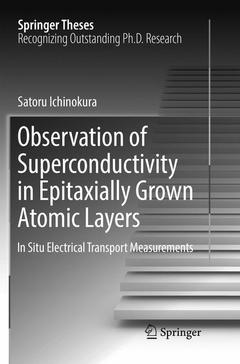Description
Observation of Superconductivity in Epitaxially Grown Atomic Layers, 1st ed. 2018
In Situ Electrical Transport Measurements
Springer Theses Series
Author: Ichinokura Satoru
Language: English
Approximative price 105.49 €
In Print (Delivery period: 15 days).
Add to cartPublication date: 02-2019
Support: Print on demand
Publication date: 11-2017
Support: Print on demand
Description
/li>Contents
/li>Biography
/li>Comment
/li>
This thesis presents first observations of superconductivity in one- or two-atomic-scale thin layer materials. The thesis begins with a historical overview of superconductivity and the electronic structure of two-dimensional materials, and mentions that these key ingredients lead to the possibility of the two-dimensional superconductor with high phase-transition temperature and critical magnetic field. Thereafter, the thesis moves its focus onto the implemented experiments, in which mainly two different materials thallium-deposited silicon surfaces and metal-intercalated bilayer graphenes, are used. The study of the first material is the first experimental demonstration of both a gigantic Rashba effect and superconductivity in the materials supposed to be superconductors without spatial inversion symmetry. The study of the latter material is relevant to superconductivity in a bilayer graphene, which was a big experimental challenge for a decade, and has been first achieved by the author.
The description of the generic and innovative measurement technique, highly effective in probing electric resistivity of ultra-thin materials unstable in an ambient environment, makes this thesis a valuable source for researchers not only in surface physics but also in nano-materials science and other condensed-matter physics.
Satoru Ichinokura, a post-doctoral researcher of the Japan Society for the Promotion of Science (JSPS) at The University of Tokyo, is an experimentalist in surface physics and nanotechnology. His work is concerned with atomic-scale thin layer systems such as graphene, transition metal dichalcogenides, and metal-induced surface reconstructions on semiconductors. He is interested particularly in spintronics aspects and low-temperature properties of those materials, represented by superconductivity, and approaches them by electric transport measurements and scanning tunneling microscopy.
Satoru Ichinokura received both his Bachelor of Physics and Master of Science in physics from Tohoku University in 2011 and 2013, respectively. Thereafter he joined the group led by Professor Shuji Hasegawa in the Department of Physics, The University of Tokyo, and received his Ph.D. in physics from The University of Tokyo in 2016. During his Master’s program, he received a research grant of Global Centers of Excellence Program from Tohoku University in 2012. During his doctoral program, he received a travel award and student award from the Surface Science Society and a Graduate School of Science award from the School of Science, The University of Tokyo, in 2014, 2015, and 2016, respectively. He was also awarded a research fellowship for young scientists from JSPS, and his research was supported by the JSPS between April 2015 and March 2017.
Nominated as an outstanding contribution by the University of Tokyo in 2016
Presents the first observations of superconductivity in one- or two-atomic-layer material
Provides an overview from individual development of bulk superconductivity and surface physics to atomic-scale-thin layer superconductivity
Reviews the novel electrical resistivity measurement for materials unstable in an ambient environment
Includes supplementary material: sn.pub/extras




